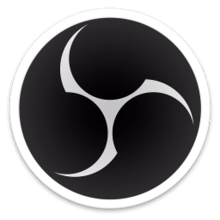Open Broadcaster Software
 | |
| Original author(s) | Hugh "Jim" Bailey |
|---|---|
| Developer(s) | Community |
| Initial release | v0.32a / 1 September 2012[1] |
| Stable release |
v22.0.2 (Studio)
/ 30 August 2018[2] |
| Repository |
|
| Written in | C, C++[2] |
| Operating system | Windows 7 and later, macOS 10.10 and later, Linux[3] |
| Platform | IA-32 and x86-64 |
| Available in | 41 languages[4] |
|
List of languages
| |
| Type | Software vision mixer, streaming media |
| License | GNU General Public License, version 2 or later[5] |
| Website |
obsproject |
Open Broadcaster Software (OBS) is a free and open-source streaming and recording program maintained by the OBS Project. The program has support for Windows 7 and later, macOS 10.10 and later, and Ubuntu 14.04 and later.
Overview
OBS is a free and open-source software suite for recording and live streaming. Written in C and C++, OBS provides real-time source and device capture, scene composition, encoding, recording, and broadcasting. Transmission of data is primarily done via the Real Time Messaging Protocol (RTMP) and can be sent to any RTMP supporting destination, including many presets for streaming websites such as YouTube, Twitch.tv, Instagram and Facebook.[6]
For video encoding, OBS is capable of using the x264 free software library,[7] Intel Quick Sync Video, Nvidia NVENC and the AMD Video Coding Engine to encode video streams into the H.264/MPEG-4 AVC format and the H.265/HEVC format. Audio can be encoded using either the MP3 or AAC codecs. Advanced users can choose to use any codecs and containers available in libavcodec / libavformat as well as output the stream to a custom ffmpeg URL.
User interface
The main user interface is organized into five sections: scenes, sources, audio mixer, transitions, and controls. Scenes are groups of sources like live and recorded video, text and audio. The mixer panel lets the user mute the audio, and adjust the volume through virtual faders, and apply effects by pressing the cogwheel next to the mute button. The control panel has options for starting/stopping a stream or recording, a button to transform OBS to a more professional Studio Mode (see below), a button for opening the settings menu and a button to exit the program. The upper section has a live video preview, used to monitor and edit the current scene. The user interface can be switched to dark or light theme depending on what the user prefers.
When in studio mode, there are 2 scene preview windows, the left one for modifying and preview of non-active scenes, while the right window is for preview of the active scene. in the middle there is a secondary transition button, allowing for transitioning to the non active scene in the left window.
There are some simple tutorials in the Internet that shows how to use Open Broadcaster Software[8][9][10]
History
Open Broadcaster Software started out as a small project created by Hugh "Jim" Bailey, but quickly grew with the help of many online collaborators working both to improve OBS and spread the knowledge about the program. In 2014,[11] development started on a rewritten version known as OBS Multiplatform (later renamed OBS Studio) for multiplatform support, a more thorough feature set, and a more powerful API.[12] As of v18.0.1 of OBS Studio, OBS Classic is no longer supported due to the former reaching near-full feature parity with the latter, though the download for Classic is still available.[13]
Plug-ins
Open Broadcaster Software supports a variety of plug-ins[3] to extend its functionality. Plug-ins are loaded as native code DLL files,[14] although a wrapper plug-in[15] is available that allows hosting of plug-ins written in the .NET Framework.
See also
References
- ↑ "Open Broadcaster Software - Changelog". The OBS Project. Archived from the original on 17 May 2013. Retrieved 27 May 2013.
- 1 2 "Open Broadcaster Software - Download". The OBS Project. Retrieved 30 August 2018.
- 1 2 "Open Broadcaster Software - Index". The OBS Project. August 2016. Retrieved 14 August 2016.
- ↑ "Locales". The OBS Project. Retrieved 10 June 2016.
- ↑ https://github.com/obsproject/obs-studio/blob/master/COPYING
- ↑ "How to stream games with Open Broadcaster: a fast, free livestreaming application - News - PC Gamer". Future Publishing Limited. Retrieved 2 June 2013.
- ↑ "x264 Home Page". VideoLan Organization. Retrieved 2011-03-11.
In addition to being free to use under the GNU GPL, x264 is also available under a commercial license from x264 LLC and CoreCodec.
- ↑ https://www.windowscentral.com/beginners-guide-obs
- ↑ https://antmedia.io/how-to-use-obs-with-ant-media-server/
- ↑ https://arcolinux.com/a-quick-tutorial-how-to-set-up-obs-studio/
- ↑ "OBS Studio Github Page". Github, Inc. Retrieved 25 February 2016.
- ↑ "OBS Homepage". The OBS Project. Archived from the original on 9 March 2016. Retrieved 25 February 2016.
- ↑ "OBS Classic is no longer supported - Here's how to easily switch to OBS Studio". The OBS Project. Retrieved 30 April 2017.
- ↑ The OBS Project. "OBS Source Code". Retrieved 24 October 2016.
- ↑ Bradley, John R. (11 August 2013). "Creating a Plugin". CatchException. Archived from the original on 23 October 2016. Retrieved 23 October 2016.
... All languages based on Microsoft’s Common Language Runtime (.NET) should be fine. This includes C#, C++/cli, Visual Basic and others. ...